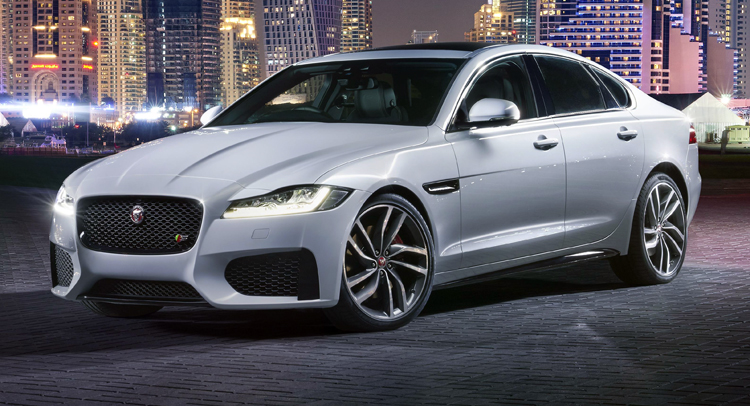What do you get when you pair a first generation XF with a new XE? Why, the second-generation XF, of course.
Presented in London today ahead of its motor show premiere in New York next week, the 2016 XF looks eerily familiar. In fact, at a first glance, most will probably have a hard time telling the differences over the outgoing car, with the devil being in the details such as the more upright front grille, Jaguar’s first ever full-LED headlamps, the addition of a third side window and the stubbier and slightly more athletic rear.
Have the German premium brands and their evolutionary tactics rubbed off on Jaguar? You could say that, but in doing so, you forget that Jaguar itself kept the same design language for the XJ for over four decades…
Speaking about the exterior styling of the new XF, Jaguar design boss, Ian Callum, said:
“In creating the all-new XF, as a design team we have been driven by discipline, the discipline of simplicity. Every exterior line on the XF has a clear purpose – nothing is superfluous. Achieving that simplicity takes time and requires great determination; it’s all too easy to add lines to a car, but much harder to add character by leaving lines out.”
The same “discipline of simplicity” can be seen inside as well, with the new XF once again blending things we’ve seen on both the current XF and the smaller XE. Owners of the first XF will feel right at home for the most part, with new elements including the central air vents now positioned on top of a larger 10.2-inch touchscreen for the infotainment system, the fully-digital and reconfigurable 12.3-inch TFT instrument cluster and the F-Type-like steering wheel.
“Inside too, we have been driven by the desire to ensure the XF’s cabin is as comforting as it is comfortable,” said Callum. “New technology, including our new 10.2-inch touchscreen, is combined carefully with materials that cosset and reassure. The all-new XF has a clear sense of calm and strength, both outside and inside – and I’m proud of my team for delivering that.”
While there’s a sense of familiarity with the design, truth is that, the 2016 XF is an all-new car underneath. Whereas the current model uses Ford underpinnings, its replacement adopts a stretched version of the XE’s iQ[AI] aluminum-intensive architecture, which Jaguar says, “enables class-leading weight: 80kgs or 176 lbs lighter than the competition”. It’s also stiffer than the structure used on the outgoing XF.
“Featuring 75 per cent aluminum, the architecture enables weight savings of up to 190kg or 419 pounds over the outgoing model and an increase in torsional stiffness of up to 28 per cent,” said Jaguar.
The new architecture led to a different packaging and altered proportions for the car, which while 7mm shorter and 3mm lower than the previous XF, has a 51mm longer wheelbase at 2,960mm wheelbase for improved rear seat space with more legroom, knee room and headroom.
Offering a near 50:50 weight distribution, the new XF features double wishbone and Integral Link suspension, along with an Electric Power Assisted Steering (EPAS) and the firm’s Jaguar Configurable Dynamics system that enables the driver to individually tailor settings of the dampers, steering, engine and eight-speed automatic transmission.
The 2016 model introduces Jaguar-Land Rover’s new Ingenium engines, including a 2.0-liter turbo diesel in two states of tune with 161hp (167PS) and 380Nm or 178hp (180PS) and 430Nm. When paired to a six-speed manual gearbox (there’s also an optional 8-speed automatic), the 161hp model returns 104g/km of CO2 emissions.
Moving up you’ll discover a 3.0-liter V6 twin-turbo diesel with 296hp (300PS) and 700Nm, and a 3.0-liter supercharged V6 delivering 375hp (380PS) and 450Nm, both linked to a standard eight-speed auto. Jaguar did not release details about the rest of the engine range, nor did it mention which ones will be available in North America.
Production of the new XF will take place at Jaguar Land Rover’s Castle Bromwich Plant alongside F-TYPE and XJ.








































